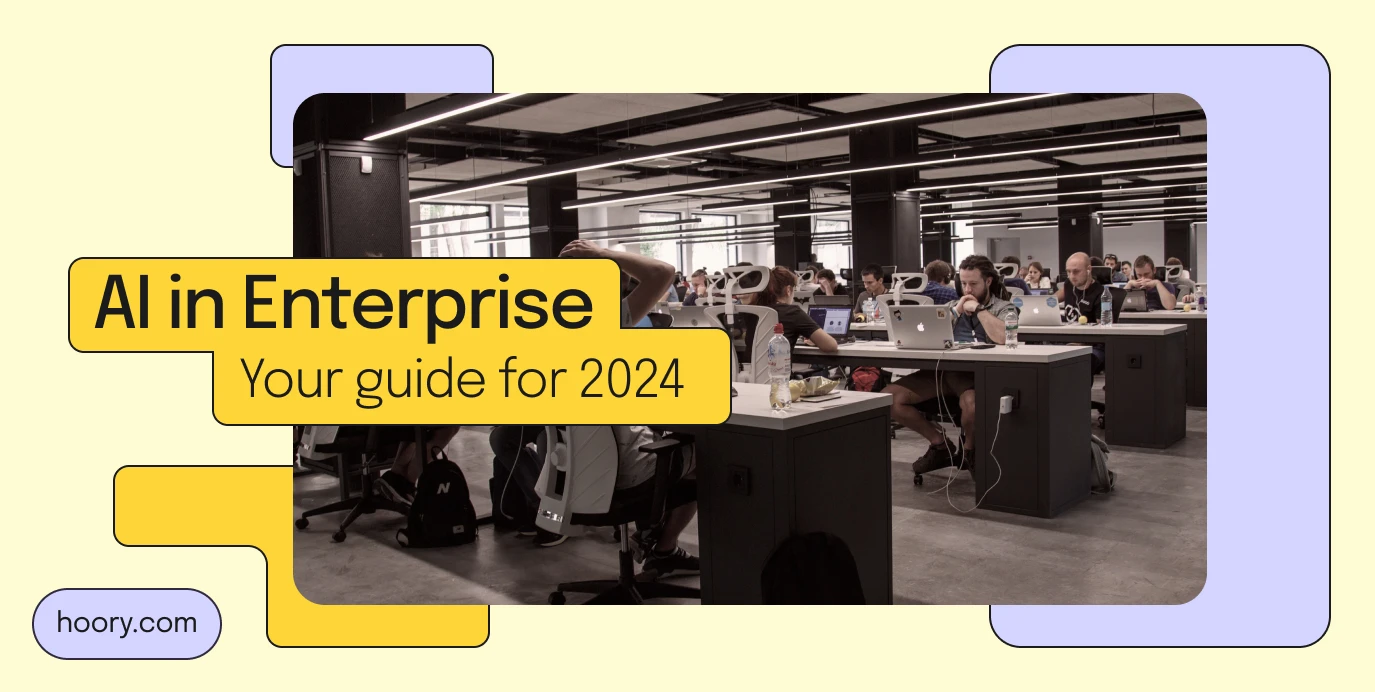How to Add AI Capabilities to Your Enterprise Ecosystem in 2025
• Customer Support
• FastBank

Artificial Intelligence (AI) has shifted from a sophisticated idea that will happen "someday" into an inevitable reality. And as it continues to revolutionize industries, incorporating AI capabilities into your enterprise ecosystem is no longer a strategic advantage but a necessity.
For those who doubt the significance of enterprise AI, Dr. Andrew Ng has an interesting comparison.
"The rise of AI resembles the rise of literacy. A few hundred years ago, many people thought that not everyone needed to be able to read and write. Back then, while most people worked in fields or took care of animals, only the high-ranking priests and monks had their hands on books and literature. So, the responsibility of interpreting the important papers was entrusted to them.
Fortunately, humanity realized that a more intelligent society could be built if most people could read and write. Today, AI is in the hands of "high priests" - top tech engineers and global enterprise leaders."
Now, think about it. How do you want to position yourself in the enterprise world? You can either be a prominent figure with AI superpowers that directs the come and go of the industry or a part of the AI-explorer crowd that merely goes along with the current trends.
The choice is yours!
Whether you're a seasoned AI enthusiast or a tech lover, the following pages will equip you with valuable insights on a successful AI integration. Read on to discover how AI can elevate your operations, drive innovation, and position your organization for future success.
Understanding the AI Landscape
Understanding the AI landscape is important for enterprises seeking to enhance their ecosystems with cutting-edge capabilities. The AI landscape has evolved significantly over the past few years, encompassing a diverse range of technologies, frameworks, and applications.
By the end of 2024, the global AI market is forecasted to value over
1 trillion dollars. Given this staggering growth, it is crucial for businesses to navigate this complex terrain to make informed decisions about incorporating AI in business.
One key aspect of comprehending AI integration is recognizing the different types of enterprise AI, ranging from rule-based systems and machine learning to advanced neural networks. Each category offers distinct advantages and is suitable for specific use cases, requiring a nuanced understanding for effective integration.
Conducting Market Research
Enterprises aspiring to integrate AI in business need to conduct thorough market research. It serves as the compass that guides decision-makers through navigating AI solutions, helping them align technological investments with business objectives.
Conducting market research for enterprise AI involves a blend of technical expertise and strategic insights. Here are some of them for those involved in this process:
-
Deep Dive Into Industry-Specific AI Use Cases
Explore industry-specific applications of AI. Understand the unique challenges and opportunities within each sector. For instance, Foxconn, a Taiwanese multinational electronics manufacturer, conducts the whole quality control process through advanced AI technologies, like computer vision and machine learning. It allows them to detect defects and anomalies, ensure product quality, and minimize errors.
-
Implement AI-Powered Social Listening
Employ AI-powered social listening tools to monitor online conversations, forums, and social media. World-famous companies like Coca-Cola and Nike use AI and natural language processing to identify emerging topics or concerns related to their products and services.
AI-driven sentiment analysis tools have the ability to classify online references as positive, negative, or neutral. This feature equips brands with a rapid understanding of public sentiment, enabling them to address issues promptly and prevent potential crises. This provides valuable inputs for product positioning and feature development.
-
Conduct Market Simulations Through Generative Adversarial Networks (GANs)
Use Generative Adversarial Networks to generate realistic market scenarios for simulation purposes. This advanced technique enables tech professionals to explore potential market dynamics, test AI models in diverse virtual environments, and prepare for a wide range of real-world scenarios.
The GAN architecture is implemented using machine learning frameworks such as TensorFlow or PyTorch, where you define and train the generator and discriminator networks, set up the adversarial training loop, and optimize the models to generate high-quality synthetic data.
These are just a few examples of how deeply you can go with your market research. However, it's important to note that market research is not just a one-time effort but an ongoing process that allows enterprises to adapt to the rapidly evolving AI world. Evaluating the AI applications in the context of the enterprise's unique requirements allows for a tailored approach to AI integration.
On the other hand, it ensures their technology investments remain aligned with industry trends and advancements. In essence, market research acts as the strategic foundation for organizations looking to seamlessly incorporate AI capabilities into their enterprise ecosystems.
Assessing Your Enterprise Readiness for AI Integration
To understand the full potential of AI implementation, you must assess your enterprise's readiness for AI integration. Let's go through the assessment stages together.
-
Assessing Data and Infrastructure Capabilities
First and foremost, it's crucial to evaluate your existing infrastructure and data capabilities. AI thrives on data, and ensuring that your enterprise possesses a robust data foundation is essential.
Evaluate the quality, volume, and accessibility of your data, and consider implementing necessary enhancements to ensure it aligns with the requirements of AI applications.
-
Assessing Workforce Proficiency
Besides, you also need to assess the skill sets within your workforce and identify gaps that may hinder seamless AI integration. Investing in training programs and fostering a culture of continuous learning can empower your teams to adapt to AI technologies effectively.
-
Assessing Ethical Regulations
Lastly, consider the regulatory landscape and ethical considerations associated with AI integration. Ensure that your enterprise adheres to data privacy regulations and industry standards. Developing a comprehensive AI strategy that aligns with your business goals and a thorough assessment of your technical infrastructure, human resources, and ethical considerations will position your enterprise for successful AI integration in 2024.
Implementing AI in Enterprise
To get started with AI integration, you need to develop a strategic blueprint of objectives.
-
Identify key performance indicators (KPIs) that will measure the impact of AI implementation. Whether it's measuring cost savings, increased productivity, or improved customer satisfaction, defining measurable KPIs will provide a tangible way to assess the effectiveness of your AI initiatives.
-
Assess customer touch points for potential AI-enhanced interactions. Customer touchpoints encompass every interaction a customer has with a brand, from browsing a website to contacting customer support. Employing AI in business allows support teams to enhance customer experiences by providing personalized and efficient services. Through natural language processing (NLP) and machine learning algorithms, companies can create chatbots or virtual agents that engage with customers in real time, answering queries, offering product recommendations, and facilitating seamless transactions.
-
Mitigating risks is another critical aspect of AI integration. Implementing comprehensive testing procedures, creating fail-safe mechanisms, and establishing clear protocols for handling system failures are necessary to minimize the impact of technical risks.
-
Assure Return on Investment (RoI) to get tangible outcomes. Clearly defining the goals and results expected from AI implementation, such as increased operational efficiency, cost reduction, or revenue growth, lays the foundation for measuring and realizing ROI.
-
Last but not least, establish a timeline for implementation, outlining milestones and deadlines to track progress. This ensures a phased and structured approach to AI integration, facilitating a smoother organizational transition.
AI Success Stories in Enterprise
There is no one-size-fits-all AI that will work for all types of enterprises. Each entity adopts AI in its distinct manner, highlighting the incredible versatility of this technology. In a sense, AI is like the new electricity. It's a general-purpose technology that is useful for countless applications.
Now, let's delve into real-world instances showcasing how AI has been integrated into extensive enterprise operations, aiming for excellence.
-
Google's DeepMind in Healthcare
Google's DeepMind developed an AI system that could analyze medical images and assist in diagnosing eye diseases. In 2018, DeepMind's AI demonstrated success by outperforming human experts in diagnosing eye conditions, particularly in the case of diabetic retinopathy.
-
Notion AI in Workflow Management
Notion AI offers a suite of powerful features to supercharge your workflow. From summarizing text and generating outlines to translating languages and checking grammar, it's your all-in-one productivity solution. Transform meeting notes into actionable items and enhance content creativity with synonyms and antonyms.
-
Synthesis AI in Synthetic Data Generation
Synthesis AI, founded in 2021, pioneers synthetic data generation with advanced AI technology. It offers a venture-backed platform at the intersection of deep learning and CGI, creating a new paradigm for computer vision model development.
-
Fireflies.AI for Automated Meeting Notes
Fireflies.AI revolutionizes productivity and collaboration with its automated note-taking and meeting transcription solution. Leveraging AI, it accurately captures and transcribes meetings, extracting key insights for teams to focus on meaningful tasks. The tool can review 1-hour meetings in 5 minutes and filter action items, tasks, questions, and other critical metrics.
-
JPMorgan Chase's Contract Intelligence
JPMorgan Chase adopted AI to streamline its legal operations by using machine learning algorithms to analyze and review legal documents. This has significantly reduced the time and resources required for contract review and improved overall efficiency in the legal department.
Besides, JPMorgan Chase is the first major bank to utilize an AI-powered virtual assistant that helps corporate clients move money around the world, be it a routine payroll or multi-million-dollar merger or acquisition.
-
Tesla's Autopilot and Full Self-Driving
Tesla has been a pioneer in the automotive industry with its Autopilot feature and ongoing development of Full Self-Driving (FSD) capabilities. Through machine learning and neural networks, Tesla's vehicles can navigate and respond to complex driving scenarios, showcasing the potential of AI in autonomous vehicles.
-
Alibaba's AI-Powered Fashion Advisor
Alibaba's FashionAI uses computer vision and deep learning to provide personalized fashion advice to customers. By analyzing clothing items and considering personal preferences, it assists users in making stylish and fitting choices.
Trends in Enterprise AI
In the past, computers operated based on rigid instructions provided by humans, but today, they're equipped to learn independently. Initially, AI development aimed to mimic human thought processes. For instance, programmers used to write instructions like measuring the eyes' size and the distance between them, evaluating the nose and face sizes, and then determining identities based on predefined criteria.
However, contemporary AI methods simplify the process by presenting the system with a collection of pictures and instructing it to discern the unique characteristics that differentiate individuals like Adam from Eve.
Now, let's see what trends are flourishing in AI enterprises in 2024.
Multimodal AI Applications
The latest buzz revolves around multimodal AI, a groundbreaking approach that goes beyond traditional data domains. While earlier AI models hinted at the potential with text-to-image or speech-to-text capabilities, multimodal AI applications can take multiple types of data as input—for example, video. Enter Google's Lumiere, a text-to-video diffusion model that tackles image-to-video tasks, getting inspiration from images for style references.
More Advanced Virtual Agents
With the acceleration of AI systems and the assimilation of various data streams, the potential of virtual agents goes beyond mere communication and instruction-following, extending into task automation. For instance, instead of simply requesting recipes, users can point a camera at an open fridge and ask for recipes based on the available ingredients. Initiatives like Be My Eyes further exemplify this trend, utilizing AI tools to empower users to interact directly with their surroundings through multimodal AI.
AI Coding
According to Gartner, by 2027, 50% of enterprise software engineers will use machine learning-powered coding tools. Automated code generation, code completion, and bug detection are becoming integral components of the developer toolkit. With the advent of advanced natural language processing models and machine learning algorithms, AI-powered coding assistants are evolving to understand and interpret complex developer queries, offering intelligent suggestions and even predicting potential code improvements.
Quick Recap
As discussed above, AI integration into your enterprise ecosystem involves a multifaceted approach. This process involves various key elements that collectively shape a company's readiness for the future. From using the power of advanced machine learning algorithms to ensuring user-friendly interfaces, AI integration must be centered around making artificial intelligence accessible and beneficial across the organization.
In a word, the path to a more intelligent and adaptive enterprise ecosystem is through AI integration. By embracing AI strategies, businesses position themselves not only to survive but to thrive in the rapidly evolving technological times we live in.

























